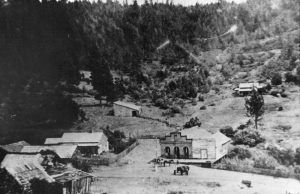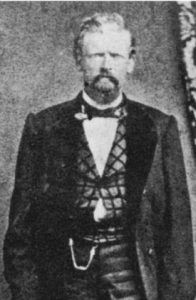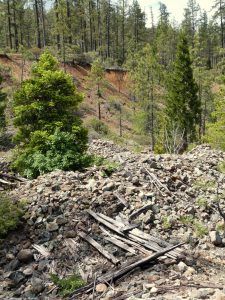The soon-to-be bustling miners’ camp of Sailors’ Diggings, Oregon, started in 1851 after a group of sailors jumped ship in Crescent City, California. Working their way to the northwest, they discovered gold near the junction of Josephine and Canyon Creeks near O’Brien, Oregon. They called their camp Sailors’ Diggings.
Word of the gold find soon spread, and prospectors swarmed to the area for their fortunes. Starting as a tent city, it wasn’t long before the settlement exploded in population and gave rise to the Waldo Mining District, established in 1852. It soon sported a blacksmith shop, a shoe shop, a butcher shop, some dry goods stores, and several hotels and saloons. It also was called home to several thousand people at a time when the entire state of Oregon had fewer than 10,000 residents. Like other booming mining camps, it also attracted rough elements.
One was the Triskett Gang, who arrived on August 3, 1852. Known for having conducted several robberies and killings in Northern California, the gang was on the run, trying to give a posse slip by crossing the border into the rugged mountains of Oregon.
Upon their arrival, most able-bodied men in the community were out working their claims or prospecting in the hills.
The five outlaws, including Jack Triskett, Henry Triskett, Fred Cooper, Miles Hearn, and Chris Stover, spent most of the afternoon spending their ill-gained loot on numerous drinks. Suddenly, one of them – Fred Cooper – walked out into the street and, without a word, pulled a revolver and shot a passerby dead.
The other gang members quickly followed him out of the saloon, and they all began firing randomly at anyone and everyone who happened to be outside. For the next 30 minutes, they stormed down the street, terrifying the town and killing 17 people, including women and children. Except for a few merchants, the village was virtually defenseless.
The last stop for the gang was the assay office, where they stole $75,000 of gold and left the assayer dead, making him murder victim # 18.
In the meantime, the miners in the nearby hills had heard the many gunshots and quickly made their way to Sailors’ Diggings. Within minutes of their arrival, a miners’ posse began to track the fugitives heading northwest towards O’Brien, a mining camp less than six miles away.
Weighed down with almost 250 pounds of gold carried on two stolen horses, the bandits weren’t moving quickly and wouldn’t be long before the posse caught up with them. The miners came upon the gang atop a little hill just outside O’Brien. Quickly surrounding the fugitives, a gunfight broke out, and four of the gang members were killed. The only surviving outlaw was Chris Stover, and the gold was nowhere to be found. Stover was taken back to town, where he died before telling anyone where the gang had hidden the stolen gold.
To this day, that gold has never been recovered, though many have tried. Some say it was stashed somewhere near the hill where the gang made their stand. But, they may have hidden their stolen loot along the trail between Sailors’ Diggings and O’Brien. It has been estimated to be worth more than $5 million today.
Despite the terrible loss of life by the Triskett Gang, Sailors’ Diggings continued to thrive. In 1853, the town’s name was changed to Waldo. Soon, the Waldo Mining District became the area’s first seat of local government and was instrumental in the formation of Josephine County, which was established on January 22, 1856, when it separated from Jackson County. Waldo became the first county seat, and the community received a post office on September 4, 1856.
In 1857, the county seat was moved from Waldo to Kerbyville because it was on the main route from California to the goldfields. Kerbyville would remain the county seat for almost 30 years before Grants Pass became the county seat in 1886 after the railroad made its way there.
Though Waldo mainly had gained a reputation for civility, its penchant for attracting rough elements was not over.
In 1859, gunfighter and gambler Ferd Patterson arrived in the mining camp, standing over six feet tall and weighing about 200 pounds. Patterson presented himself as a “dandy,” wearing cashmere shirts, silk vests, and a long black frock coat trimmed with fur. His outfit also consisted of an ivory-handled Colt .31 caliber revolver and matching Bowie knife.
He wasn’t in Waldo to use a pick and shovel in the nearby mines. Instead, he quickly began to make the rounds of the gaming tables in the saloons of the area. The local miners were no match for the prolific gambler and lost much of their hard-earned money to the visiting stranger. On one occasion, Patterson was said to have gotten into an argument with two local miners over a card game and promptly gunned them both down.
He also got on the wrong side of George Wells, the local lawman who was a former Texas Ranger. One afternoon, in front of a saloon, the two men got into an argument, which soon led to gunplay. Wells shot Patterson in the side, but as Patterson went down, he continued shooting, hitting Wells in the arm. Both men recovered from their wounds, although Wells ended up with a permanently disabled arm. Afterward, Patterson was run out of town. Patterson would continue his gambling and gunfighting ways across Oregon, California, and Idaho before he was killed in February 1866 in Walla Walla, Washington.
The notorious outlaw Boone Helm, who would later make a name for himself with the Henry Plummer Gang in Montana, arrived in Waldo in about 1863. He was on the run from California and headed to The Dalles, Oregon, widely reputed as a safe haven for criminals. During his stay in Oregon, Boone was said to have killed several men.
When Helm begged for food from a local farmer, unaware of Helm’s murderous reputation, the old man took pity on him and invited him into his home. After accepting the farmer’s kindness and charity for several weeks, Helm planned on killing the man, rustling his cattle, and stealing any valuables he might have owned. Fortunately, the farmer was warned of the outlaw’s plan, and Helm, meeting the end of the farmer’s shotgun, fled the property. Like Ferd Patterson, Helm was quickly chased out of the county by the townsmen. Montana Vigilantes would later hang Helm on January 14, 1864
At its peak, the Waldo area was said to have been called home to as many as 30,000 residents. In 1860, the town had three hotels, a livery stable, several blacksmith shops, a bowling alley, a Chinese boarding house, several hotels and saloons, and a brewery.
However, like other mining boomtowns in the American West, Waldo would not last.
By the 1880s, many miners had left the vicinity and headed to Kerbyville. Others went to the new strikes on the Frasier River.
In 1919, a land development company sold speculation housing lots, but they were unsuccessful. Afterward, property values dropped, and a few years later, the entire town was purchased by a local miner.
In 1927, Waldo was leveled mainly by giant hydraulic equipment, washing out what was left of the gold. In December 1928, Waldo’s post office was closed.
During the 1930s, it was discovered that Waldo had been built upon a rich gravel bench, and a local mining company soon purchased the townsite.
All that is left today is the hilltop cemetery, which watches over the once-thriving community.
The Waldo Mining District, which pre-dates the creation of the State of Oregon, still exists and fights for mining rights in Oregon.
The site of old Waldo is situated on private land about five miles north of the border with California near the present-day town of Cave Junction.
From Cave Junction, drive south on Highway 199 towards Crescent City, California. At 6.6 miles, turn left onto Waldo Road. At 2.7 miles, a dirt embankment is topped with large rocks and a metal gate.
© Kathy Alexander/Legends of America, updated January 2024.
Also See:
Ferd Patterson – Living and Dying by the Gun
Sources:
Ancient Lost Treasures
Dusty Old Thing
Offbeat Oregon
Oregon Gold
Pacific Northwest Photo Blog




